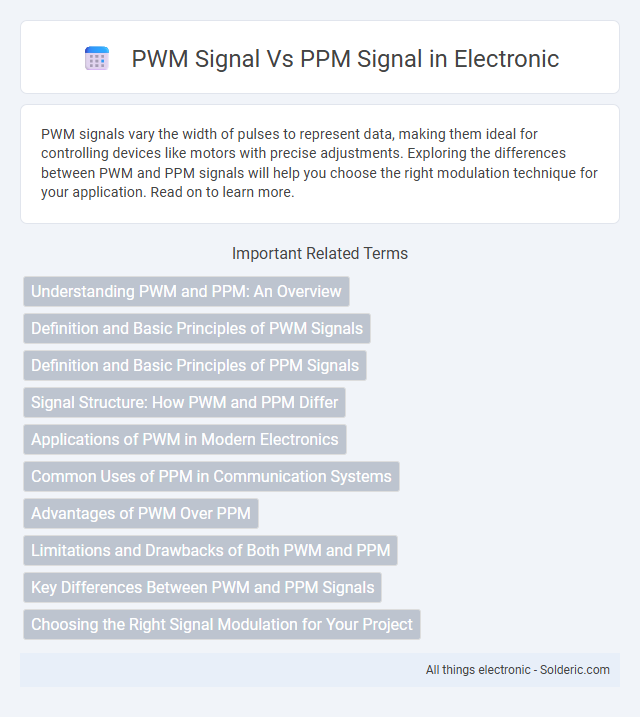PWM signals vary the width of pulses to represent data, making them ideal for controlling devices like motors with precise adjustments. Exploring the differences between PWM and PPM signals will help you choose the right modulation technique for your application. Read on to learn more.
Comparison Table
| Aspect | PWM Signal (Pulse Width Modulation) | PPM Signal (Pulse Position Modulation) |
|---|---|---|
| Definition | Modulates signal by varying pulse width | Modulates signal by varying pulse position |
| Signal Type | Time duration variation | Pulse timing variation |
| Data Representation | Pulse width corresponds to data value | Pulse position encodes data value |
| Bandwidth | Higher bandwidth requirement | Lower bandwidth usage |
| Noise Immunity | Moderate, susceptible to pulse width distortion | Higher, less affected by amplitude noise |
| Complexity | Simple generation and decoding | More complex timing detection |
| Common Applications | Motor control, LED dimming, servos | Remote control systems, RC transmitters |
| Synchronization | Continuous pulse with variable width | Uses frame synchronization pulse |
Understanding PWM and PPM: An Overview
PWM (Pulse Width Modulation) signals control device power by varying the width of fixed-frequency pulses, enabling precise control of voltage and current. PPM (Pulse Position Modulation) signals encode information by shifting the timing of pulses within a fixed interval, optimizing bandwidth usage in communication systems. Understanding the distinct modulation techniques of PWM and PPM is essential for applications in motor control, data transmission, and signal processing.
Definition and Basic Principles of PWM Signals
Pulse Width Modulation (PWM) signals are defined by varying the duty cycle of a constant frequency digital waveform to encode information or control power delivery. The basic principle involves adjusting the width of each pulse in proportion to the desired signal amplitude, maintaining a fixed period or frequency. PWM is widely used in applications such as motor speed control, LED dimming, and communication systems due to its efficiency in managing analog values using digital signals.
Definition and Basic Principles of PPM Signals
Pulse Position Modulation (PPM) signals encode information by varying the position of each pulse within a fixed time frame, unlike Pulse Width Modulation (PWM) which varies the pulse width. PPM signals consist of a series of pulses where the timing between pulses shifts according to the data being transmitted, offering reduced susceptibility to amplitude noise. Your system can benefit from PPM's precise timing characteristics, especially in remote control and communication applications.
Signal Structure: How PWM and PPM Differ
PWM (Pulse Width Modulation) signals vary the width of each pulse to convey information, maintaining a constant pulse period while modulating the duration of the high state. PPM (Pulse Position Modulation) signals encode data by varying the position of each pulse within a fixed time frame, keeping pulse width constant but shifting when the pulse occurs relative to a reference point. This fundamental difference in signal structure makes PWM sensitive to pulse width changes for amplitude control, whereas PPM relies on timing variations to transmit data effectively.
Applications of PWM in Modern Electronics
PWM (Pulse Width Modulation) signals are widely used in modern electronics for controlling motor speed, adjusting LED brightness, and regulating power in DC-DC converters. Their ability to efficiently manage power delivery makes them ideal for applications in automotive electronics, robotics, and renewable energy systems. PWM signals also enable precise control in audio amplification and communication systems, enhancing performance and energy efficiency.
Common Uses of PPM in Communication Systems
PPM (Pulse Position Modulation) signals are widely used in remote control systems, such as model aircraft and drones, due to their resilience to signal degradation and noise. PPM's efficient encoding allows multiple channels to be transmitted over a single wire or radio frequency, making it ideal for telemetry and data communication in constrained environments. Your choice of PPM in communication systems enhances reliability and precision compared to PWM (Pulse Width Modulation), particularly in applications requiring synchronized multi-channel data transmission.
Advantages of PWM Over PPM
PWM (Pulse Width Modulation) signals offer superior noise resistance and more precise control compared to PPM (Pulse Position Modulation) signals, making them ideal for applications requiring accurate signal integrity. The consistent pulse frequency in PWM enhances signal stability and reduces the impact of timing errors common in PPM systems. Your electronic devices benefit from easier decoding and reduced susceptibility to signal distortion when utilizing PWM signals.
Limitations and Drawbacks of Both PWM and PPM
PWM signals face limitations such as susceptibility to noise interference and limited bandwidth, which can degrade signal quality during transmission. PPM signals, while more bandwidth-efficient, suffer from synchronization challenges and higher sensitivity to timing errors, potentially causing data misinterpretation. Understanding these drawbacks is crucial for optimizing your communication system's performance depending on the application requirements.
Key Differences Between PWM and PPM Signals
PWM (Pulse Width Modulation) signals vary the duration of each pulse to encode information, while PPM (Pulse Position Modulation) signals encode data by varying the position of pulses within a fixed time frame. PWM's pulse width changes control power delivery in applications like motor speed control, whereas PPM is commonly used in remote control systems to transmit multiple channels with reduced interference. The fundamental difference lies in PWM modulating pulse duration and PPM modulating pulse timing, impacting signal robustness and complexity in communication systems.
Choosing the Right Signal Modulation for Your Project
PWM signals modulate the width of pulses to represent information, offering precise control in applications like motor speed and LED brightness, while PPM signals encode data by varying the position of pulses, enabling efficient multi-channel communication ideal for remote controls. Selecting between PWM and PPM depends on your project's requirements for resolution, bandwidth, and complexity; PWM provides straightforward single-channel control, whereas PPM excels in compact, multi-channel transmission. Understanding these modulation techniques ensures optimal performance, signal integrity, and resource utilization in embedded systems and communication projects.
PWM signal vs PPM signal Infographic

 solderic.com
solderic.com